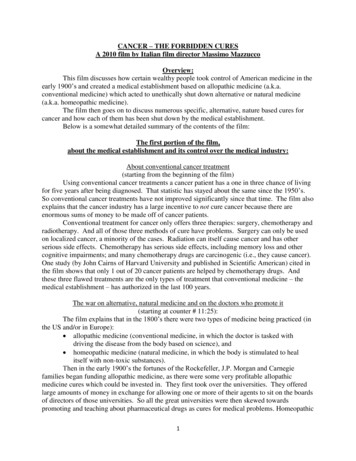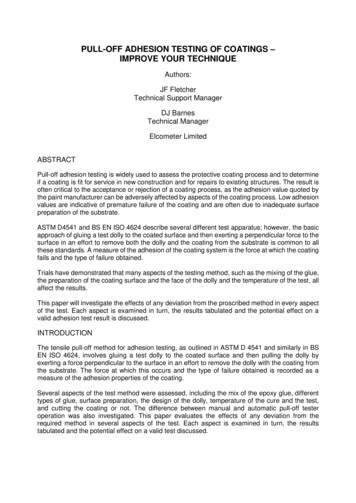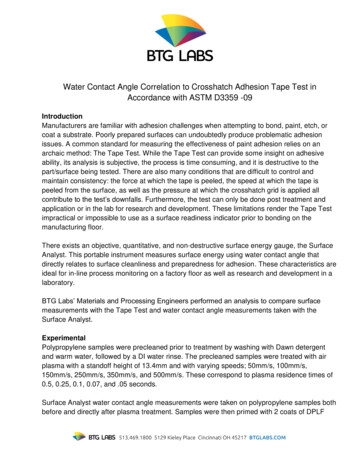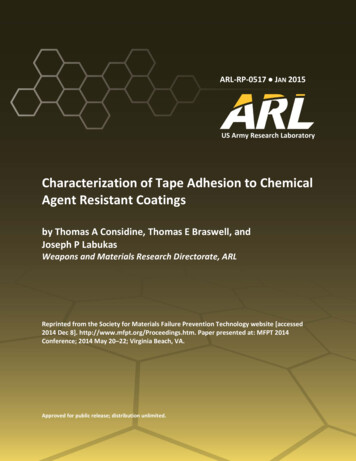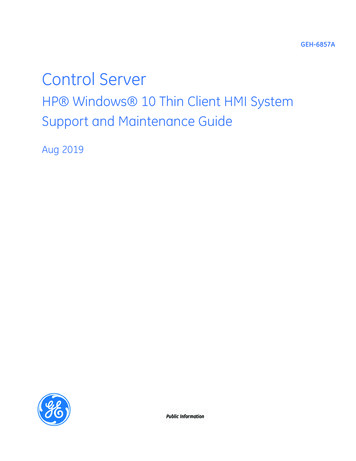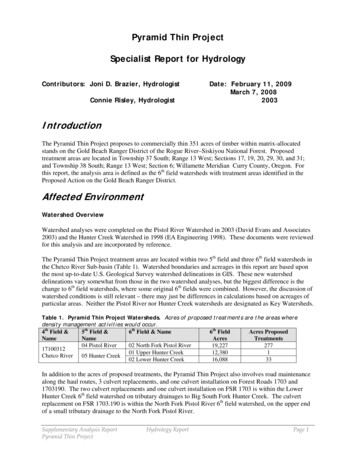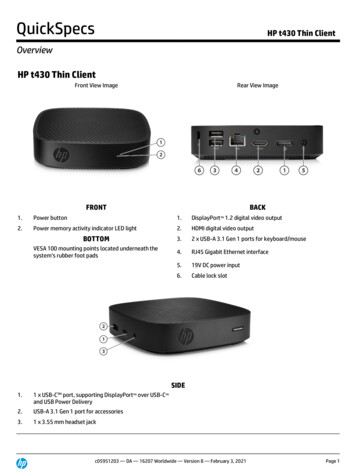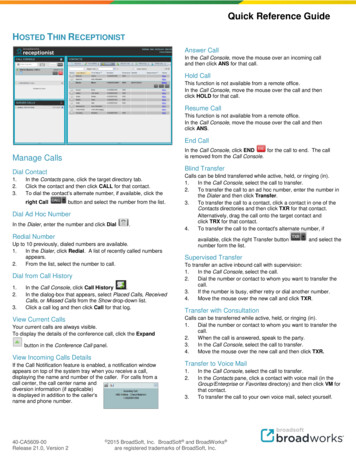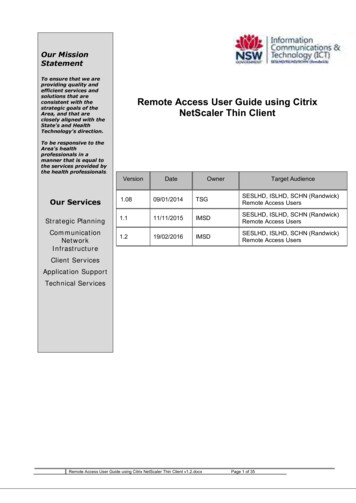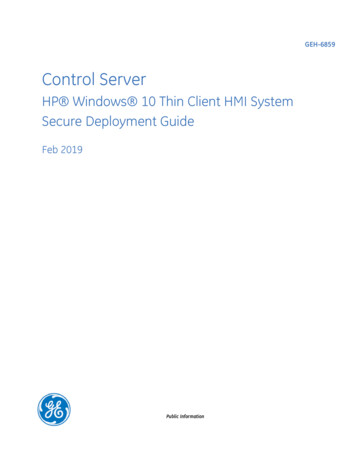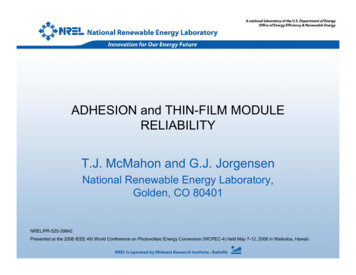
Transcription
ADHESION and THIN-FILM MODULERELIABILITYT.J. McMahon and G.J. JorgensenNational Renewable Energy Laboratory,Golden, CO 80401NREL/PR-520-39842Presented at the 2006 IEEE 4th World Conference on Photovoltaic Energy Conversion (WCPEC-4) held May 7-12, 2006 in Waikoloa, Hawaii.
Disclaimer and Government LicenseThis work has been authored by Midwest Research Institute (MRI) under Contract No. DE-AC36-99GO10337 with the U.S.Department of Energy (the “DOE”). The United States Government (the “Government”) retains and the publisher, by acceptingthe work for publication, acknowledges that the Government retains a non-exclusive, paid-up, irrevocable, worldwide license topublish or reproduce the published form of this work, or allow others to do so, for Government purposes.Neither MRI, the DOE, the Government, nor any other agency thereof, nor any of their employees, makes any warranty, expressor implied, or assumes any liability or responsibility for the accuracy, completeness, or usefulness of any information, apparatus,product, or process disclosed, or represents that its use would not infringe any privately owned rights. Reference herein to anyspecific commercial product, process, or service by trade name, trademark, manufacturer, or otherwise does not constitute orimply its endorsement, recommendation, or favoring by the Government or any agency thereof. The views and opinions of theauthors and/or presenters expressed herein do not necessarily state or reflect those of MRI, the DOE, the Government, or anyagency thereof.
OutlineWe measure the weakest adhesion between layers ofvarious thin-film (T-F) modules/samples.A-Si or CdTeGlassSnOT-F CellEVABacksheetA-Si or CIGSGlass/ETFEEVAT-F CellSS/glassEVABacksheet
Outline We measure the weakest interlayer adhesion between layersof various thin-film (T-F) modules/samples.– An Instron mechanical testing unit is used to measure peelstrengths at 90 or 180 on laminations of three T-F technologies, before and after damp heat / UV and at elevated temperatures.– ASTM D3359 - scratch and tape pull test to evaluate celladhesion strengths.
Outline We measure the weakest interlayer adhesion between layers ofvarious thin-film (T-F) modules/samples.– An Instron mechanical testing unit is used to measure peel strengths at90 or 180 on laminations of three T-F technologies, before and after damp heat / UVin one instance at elevated temperatures.– In some cases, a scratch and tape pull test to evaluate inter-cell layeradhesion strengths. Measure effect of higher temperature and relative humidity (RH)adhesion/cohesion.
Outline We measure the weakest interlayer adhesion between layers ofvarious thin-film (T-F) modules/samples.– An Instron mechanical testing unit is used to measure peel strengths at90 or 180 on laminations of three T-F technologies, cell contact layers to glass, contact layers to the semiconductor, encapsulant to cell, glass, or backsheet, etc.– before and after damp heat / UV– in one instance at elevated temperatures.– In some cases, a scratch and tape pull test to evaluate inter-cell layeradhesion strengths. Effect of higher temperature and relative humidity (RH)adhesion/cohesion. Adhesion’s effect on thin-film (T-F) module reliability.
SnO2 DelaminationCause: Heat, humidity, and high voltage,
Bubble-type DelaminationCause: Heat and tensile stress.
Adhesion Pull Samples
Instron Peel TestGripEncapsulant /BacksheetAlignmentPlateSubstrateGrip180
Adhesion Strength TableDevice:Sourcea-Si:ASiOxNy /Ni paste/Graphite/CdTe: BWeatheringFailureInterfaceEVA / a-SiEVA / a-SiEVA / SiOxNyTime092 Ny / Nipaste256 h85/854.53-h dry-out after removal from 85 C/85% RH
Adhesion Strength TableWeatheringFailureInterfaceEVA / a-SiEVA / a-SiEVA / SiOxNyTime092 Ny / NipasteEVA / SiOxNySiOxNy / CdTe256 h0085/85nonenone4.57.02.0SiOxNy / CdTeEVA / SiOxNy256 ne1.0(middle)EVA / SiOxNyEVA / MetalCdTeEVA / MetalCdTeEVA / MetalCdTeEVA / MetalCdTe0none0.7(right)CIGS:D1CIGS:D260 C80 CMetal / CdTeCIGS / MoEVA / CIGSEVA / CIGSEVA cea-Si:ASiOxNy /Ni paste/Graphite/CdTe: BSiOxNy /CdTe: BSiOxNy /CdTe: CCdTe: CCdTe: CCdTe: C(left)none nonenoneWeatheringDevice:SourceCIGS: ECIGSCIGSCIGSCIGSCIGSFailureInterfaceEVA / CIGSCIGS / MoEVA / CIGSTefzel / EVAStainless / EVAEVA / CIGSTime00258 h258 h258 h7 moCIGSEVA / CIGS16 moCIGSTPE/EVA/Glass: FcontrolTPE/EVA/Glass: FexposedTedlar/EVA/Glass: GcontrolTedlar/EVA/Glass: GexposedScotchTape/GlassASTMTape/GlassStainless / EVAEVA / Glass16 mo0EVA / Glass16 h7 yrequal 16 h0EVA / GlassEVA / GlassEVA / GlassEVA / GlassTypenonenone85/8585/8585/85Cocoa, 60.020.50.80.90.85.585/853.8UV lamp85/85none2.01.53.285/851.8EVA / GlassEVA / Glass17 h7 yrequal 17 hUV lamp85/850.40.4Tape / Glass0none0.08Tape / Glass0none0.4
CdTe:B cell peel tested
Instron peel data: CdTe cell180 Peel Strength (N/mm)87654BeforeDamp Heat3After 256 hDamp Heat2100510152025Peel Extension (mm)3035
Instron peels: two Si-modulesF1, Control: 5.5 (N/mm)G1, Control: 3.2 (N/mm)
Instron peels: two Si-modulesF1, Control: 5.5 (N/mm)F2, 7 yr UV: 2.0G1, Control: 3.2 (N/mm)G2, 7 yr UV: 0.4
Instron peels: two Si-modulesF1, Control: 5.5 (N/mm)Plus 16h DH: 3.8F2, 7 yr UV: 2.0Plus 16h DH: 1.5G1, Control: 3.2 (N/mm)Plus 16h DH: 1.8G2, 7 yr UV: 0.4Plus 16h DH: 0.4
CIGS:D2 De-encapsulation
EVA Peel Strength vs. TemperatureCIGS:D2TemperatureFailure25 C60 C80 CEVA / CIGSEVA / CIGSEVA cohesive180 PeelStrength(N/mm)7.01.10.05
Bubble-type Delamination
ASTM D 3359-02 scratch testA lattice pattern is scratchedinto the coated surface withsix or seven lines in eachdirection.Any loose fragments arebrushed away.The ASTM qualified tape ispressed firmly to that area.CIGS:D2 7 N/mmWithin 30 to 90 s, the tape ispulled back at a 180 angle.The ASTM-designated tapewould exert a force of 0.4N/mm on any cell materialdisturbed or loosened by thescratch
ASTM D 3359-02 scratch testCIGS:D2CIGS:D1 7 N/mm0.05 N/mm (CIGS/Mo)Tarrant, D. E.; Gay, R. R. (1995). Research on High-Efficiency, Large-AreaCuInSe2-Based Thin-Film Modules: Final Subcontract Report,16 August 1993 - 30 June 1995. 99 pp.; NREL Report No. TP-413-8121. (83014.PDF)
ASTM D 3359-02 scratch testa-Si:ACdTe:B 3.8 N/mm 5.6N/mm
Summary Measured interface peel strength values of various T-F moduletechnologies and how they are affected by environmental stress;some were quite low.
Summary Measured interface peel strength values of various T-F moduletechnologies and how they are affected by environmental stress;some were quite low. Adhesion at higher T and RH, and after extended UV and RHexposure show a reduction in strength.– Minimum adhesion strength defined at higher T and RH.– The softening of EVA near 85 C can lead to failure.
SummaryMeasured interface peel strength values of various T-F moduletechnologies and how they are affected by environmental stress; somewere quite low.Adhesion at higher T and RH, and after extended UV and RH exposureshow a reduction in strength.A minimum adhesion strength defined at higher T and RH.The softening of EVA near 85 C can lead to failure.Achieve highest adhesion possible for corrosion and water ingressreduction.
Summary Measured interface peel strength values of various T-F moduletechnologies and how they are affected by environmental stress;some were quite low. Adhesion at higher T and RH, and after extended UV and RHexposure show a reduction in strength.– A minimum adhesion strength perhaps at higher T and RH.– The softening of EVA near 85 C can lead to failure. Achieve highest adhesion possible for corrosion and water ingressreduction. Interlayer adhesion in a T-F cell can be quite small and within a T-Ftechnology the ASTM D 3359-02 “Measuring Adhesion by Tape Test”can be useful as a screening test.
ASTM D 3359-02 scratch test CIGS:D2 7 N/mm A lattice pattern is scratched into the coated surface with six or seven lines in each direction. Any loose fragments are brushed away. The ASTM qualified tape is pressed firmly to that area. Within 30 to 90 s, the tape is pulled back at a 180 angle. The ASTM-designated tape would exert a force of 0.4 N/mm on any cell material disturbed or loosened .
